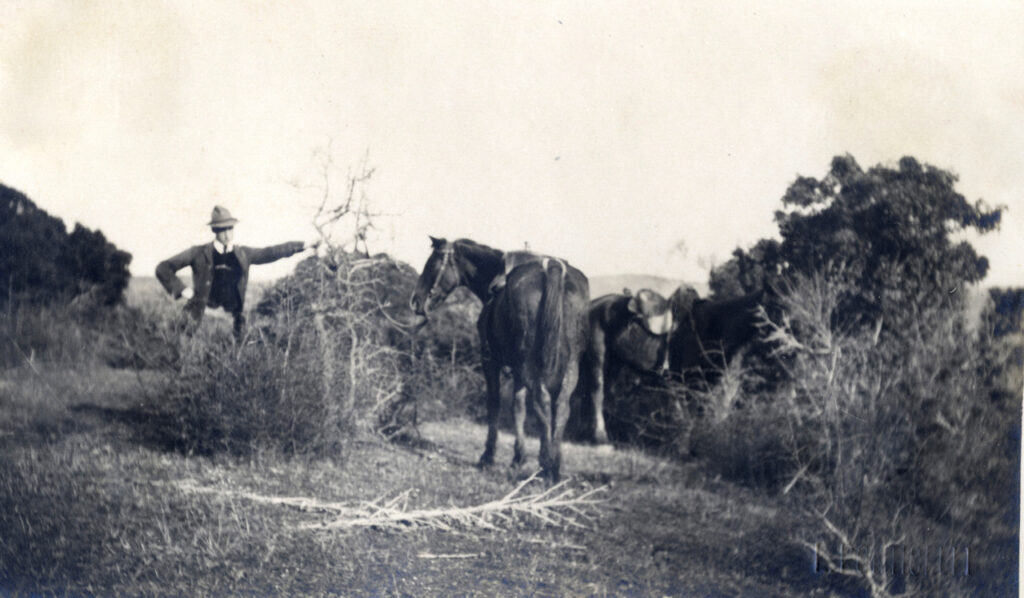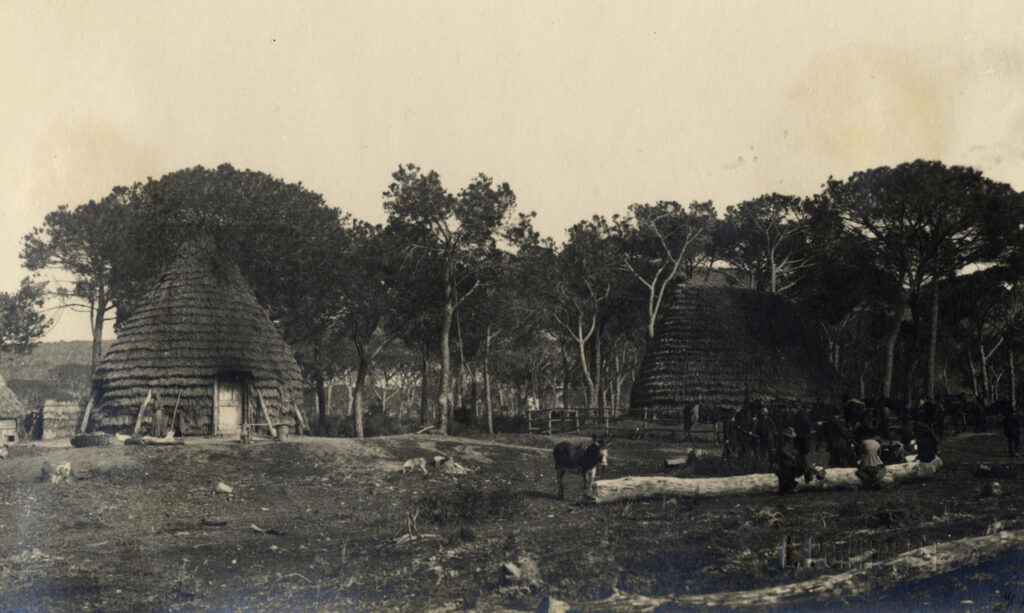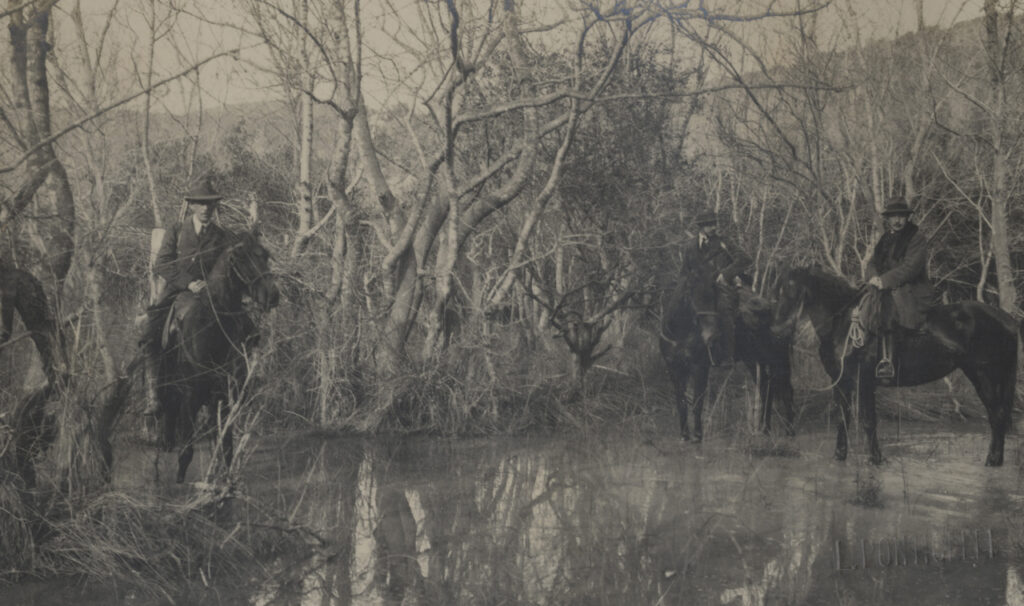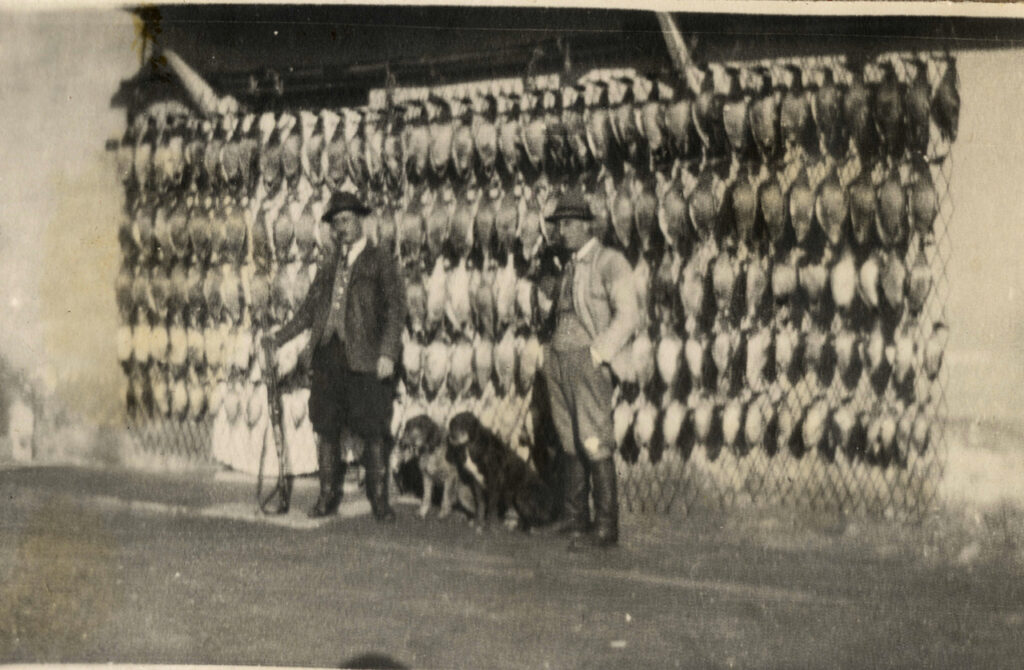The dawn of history
As far as archaeologists have managed to discover, the oldest human presence in the Park territory dates back something like 50,000 years. His traces were found in a cave at the base of the Uccellina hills. Humanity is that of Neanderthals, and the environment is cold and dry, already populated by deer, roe deer and foxes, but still crossed by wild oxen, hyenas and cave lions. We are in the middle of the ice age and the sea is far away, because the level is much lower than today.
That world ends around 11,000 years ago, when the ice age ends and sea levels rise. The Uccellina hills are covered by an uninterrupted blanket of gigantic holm oaks that descends to the seashore. To the north, however, there is a large gulf with shallow waters that reaches the area where the current Grosseto is located.
The landscape remained this way for a long time, until 3000-2300 BC. around, when instead of small bands of Homo sapiens hunters and gatherers, farmers arrived in force, having landed in southern Italy from the Middle East just over four thousand years earlier. But to create cultivated fields and graze domestic animals, the woods must be cut down. To obtain wood for cooking, heating, building houses and fences, and above all producing the coal needed to smelt iron ore – near here there are the largest metal deposits in the Mediterranean – you have to cut down more woods, let them regrow for fifteen or twenty minutes. years and then cut them again. The coppicing system was now born, which is based on the ability of the holm oak to send back new stems from the cut base, and which will last for millennia.




Nel manto boscoso della regione si aprono spazi aperti sempre più grandi, dove l’erosione dei suoli e delle rocce produce enormi quantità di sedimenti che il fiume Ombrone getta nel golfo. Presto, fra l’estremità nord dell’Uccellina e l’attuale Castiglione della Pescaia, le correnti marine cominciano ad accumulare grandi cordoni di sabbia. In epoca etrusca, quindi a partire dall’ottavo secolo avanti Cristo, il golfo si è ormai trasformato in una immensa laguna salmastra che sarà chiamata “lago Prile”, sulla quale si affacciano i centri di Vetulonia e Roselle. Nel territorio del Parco, gli etruschi sembra siano stati presenti solo a Talamone, ma la loro impronta sulla regione è forte. Nell’Etruria meridionale si producono olio e vino che vengono esportati in tutto il Mediterraneo occidentale dalle navi che lo imbarcano nei porti sul lago Prile.
All’inizio del terzo secolo avanti Cristo, l’Etruria meridionale è ormai conquistata dai romani. Viene costruita la consolare Aurelia vetus, la grande strada costiera che passa per Talamone e Alberese, dove si trovano due grandi stazioni di sosta. La popolazione aumenta rapidamente, e altrettanto rapidamente aumenta la pressione sui boschi, al punto che di quelli originari restano forse solo alcuni boschi sacri. Le pianure costiere, dove ci sono i terreni più fertili e più vicini ai porti e all’Aurelia, si riempiono di villae, grandi aziende agricole con manodopera servile create grazie agli investimenti dei senatori romani, che vi si fanno costruire splendide dimore. Alcune rovine si vedono ancora alle pendici meridionali dell’Uccellina, vicino a Talamone. Si esportano olio e vino in ogni angolo dell’impero, si pesca nel lago Prile che è un ecosistema eccezionalmente produttivo, e si produce carne sui prata, grandi pascoli specializzati per i bovini.
Quella che un giorno sarà chiamata “Maremma” è una regione florida, un giardino densamente popolato. Nel frattempo, però, l’Ombrone continua a portare ogni anno immense quantità di sedimenti, trasformando i bassi fondali del lago Prile in nuova pianura, che raggiunge ormai la punta settentrionale della catena dell’Uccellina. Qui, nella località oggi chiamata Scoglietto, sorge un tempio dedicato a Diana, e nei pressi ci sono un porto fluviale e un ponte sul quale l’Aurelia supera l’Ombrone.
Nel terzo secolo dopo Cristo le cose cominciano a farsi difficili. In concomitanza con una grave crisi economica che coinvolge tutto l’impero, il clima si fa più piovoso, quindi aumentano l’erosione e il trasporto di sedimenti da parte dell’Ombrone. Parti della pianura e del lago Prile cominciano a trasformarsi in grandi paludi di acqua dolce nelle quali si diffonde la malaria. Ci sono sempre meno manodopera e meno risorse per le sistemazioni idrauliche che consentirebbero di bonificare le paludi. Le villae diminuiscono di numero trasformandosi in grandi latifondi che producono soprattutto cereali. Inizia così l’abbandono del territorio e si innesca un ciclo perverso di impaludamento, diffusione della malaria, crisi demografica, povertà, scarsa manutenzione delle opere idrauliche, nuovo impaludamento. L’arrivo delle ondate di barbari goti e visigoti, le incursioni piratesche dei vandali e la guerra greco-gotica fanno precipitare la situazione. Il sesto secolo, in una regione ormai cristianizzata, vede la fine dei paesaggi antichi.
La popolazione rimasta abbandona la costa e si rifugia sulle alture nell’entroterra, dove nel frattempo sono ricresciuti i boschi. Quello che è stato un giardino prima degli etruschi e poi dei romani diventa una zona quasi impraticabile, che fra il settimo e il nono secolo non lascerà quasi testimonianze archeologiche: come se le sue popolazioni siano scomparse senza lasciare traccia.
Qui Carlo Magno crea la regione Maritima Regio, da cui nasce il nome “Maremma”, e la affida agli Aldobrandeschi, che la domineranno fino al quattordicesimo secolo. Mentre la Toscana dell’interno sta diventando il nuovo fulcro della civiltà italiana ed europea, la costa maremmana rimane esclusa e isolata, destinata a una depressione di lungo periodo.
I boschi però sono ricresciuti e le immense pianure malariche, mortali per l’uomo, sono ricchissime di vita selvatica, perché le paludi sono fra gli ecosistemi più produttivi del pianeta.
Dopo il Mille, la zona dell’attuale Parco vive però un periodo di ripresa. Il territorio produce risorse importanti: carbone dai boschi, sale dalle saline a bocca d’Ombrone, pesca da Talamone. Per controllarle, e riaffermare il potere della Chiesa rispetto alle mire di Siena e degli Aldobrandeschi, intorno al 1100 il papa fonda sulle alture dell’Uccellina l’abbazia di San Rabano, che per un paio di secoli vi porterà nuova vita. L’abbazia amministra lo sfruttamento economico del territorio circostante, controlla il piccolo scalo di Cala di Forno dove si imbarcano merci e persone, riporta un minimo di civiltà e di cultura. La peste nera della metà del Trecento mette però fine a tutto questo, l’abbazia di San Rabano viene abbandonata e di lì a poco la Maremma cade nelle mani di Siena.
Siena organizza un sistema di sfruttamento dei vasti e spopolati territori maremmani che durerà per secoli. A partire dalla metà del Trecento, la regione diventa un immenso pascolo per le pecore che vi scendono dall’Appenino e dall’Amiata lungo i percorsi della transumanza in settembre, per andarsene prima dell’inizio dell’estate, quando torna il pericolo della malaria. Nel 1419 viene istituita la Dogana dei Paschi, che concede a ogni pastore di percorrere qualsiasi territorio della Maremma, a chiunque appartenga, in cambio di un affitto proporzionale al numero delle sue pecore. Il denaro, naturalmente, è per la città di Siena, e in modo analogo sono organizzati la produzione di cereali, lo sfruttamento dei boschi e quello delle risorse della caccia e della pesca, che vengono portate nei mercati delle città. Si tratta in pratica di una sorta di sfruttamento coloniale, che porta al completo abbandono di aree vastissime: alla metà del Quattrocento la Maremma tocca probabilmente il suo minimo demografico.
Poco cambia quando la Maremma passa dal dominio di Siena a quello di Firenze. I Medici cominciano a interessarsi a progetti di bonifica delle paludi, ma si limitano a piccoli interventi estemporanei che non cambiano la situazione. I proprietari terrieri sono restii a investire in lunghi e costosi lavori di bonifica, e preferiscono continuare a percepire le rendite parassitarie dei latifondi e dei paduli. Gli stessi Medici ricavano un terzo delle entrate di famiglia dal monopolio della pesca nel lago di Castiglione della Pescaia – quel che resta del lago Prile – una palude malarica di cinquanta chilometri quadrati che d’estate si trasforma in un “immenso e mortifero padule”.
A partire dal Cinquecento si fanno particolarmente intense sulla costa le incursioni dei pirati barbareschi, e i Medici sono costretti a investire nella costruzione o nel rinnovamento di un sistema di torri di avvistamento, dieci delle quali si trovano ancora nel territorio del Parco.
Fino a tutto il Settecento, con l’eccezione di Grosseto, Pitigliano e qualche castello sull’Amiata, la Maremma non ha praticamente centri abitati, né strade. Dall’autunno alla primavera è abitata da boscaioli, carbonai e pastori poverissimi che ricostruiscono ogni anno le loro capanne di fango e canne. D’estate, anche l’amministrazione di Grosseto, insieme agli abitanti che hanno la possibilità di farlo, si trasferisce in collina a Scansano. Questa abitudine, la cosiddetta “estatatura”, continuerà fino ai primi anni del Novecento.
Le cose cominciano a cambiare solo con l’arrivo della dinastia dei Lorena.
I nuovi granduchi di Toscana sono i primi dopo secoli a non considerare più la Maremma una terra da rapinare, ma addirittura una “figlia malata” alla quale dedicare speciali attenzioni. Comincia Pietro Leopoldo, con il progetto di bonificare il lago di Castiglione. Il tentativo non riesce, ma il problema dello sviluppo della Maremma viene per la prima volta affrontato in modo sistematico, non solo con soluzioni idrauliche ma anche con profonde riforme economiche, sociali e politiche che cominciano a produrre i primi frutti. Le prime grandi bonifiche riesce però a portarle avanti Leopoldo II nei primi decenni dell’Ottocento. Con l’aiuto del geniale ingegnere idraulico Alessandro Manetti, il granduca dà il via alla bonifica del lago di Castiglione “per colmata”, cioè scavando canali per portarvi le piene dell’Ombrone cariche di sedimenti, perché appunto lo riempiano. È un’operazione colossale, che tra il 1820 e il 1859 consente di recuperare oltre 9000 ettari di terra. Anche il padule di Alberese, periodicamente inondato dalle piene dell’Ombrone, viene parzialmente essiccato, e in tutta la Maremma si costruiscono strade e fattorie. È in questo periodo che i Lorena fanno impiantare lungo le costa le gigantesche pinete che ancora la caratterizzano, compresa quella che si trova oggi nel Parco, fra le colline dell’Uccellina e l’Ombrone.
Dopo l’Unità, il nuovo stato italiano si disinteressa della Maremma. Solo nella Tenuta dell’Alberese, quindi nel territorio dell’attuale Parco, Ferdinando di Lorena continua l’opera. Scava nuovi canali di scolo per le acque, riporta le colture della vite e dell’ulivo, e costruisce Spergolaia, un’azienda agricola modello dotata di fienili, capannoni, stalle razionali, abitazioni per i lavoratori e un enorme granaio, oltre che delle più moderne macchine agricole.
Tra Ottocento e Novecento questa parte di Maremma comincia a cambiare, ma è ancora un paradiso per i cacciatori, che adesso possono arrivare con la nuova ferrovia Livorno-Chiarone. A loro è riservata tutta la parte più alta delle colline dell’Uccellina, con un lunghissimo muro (ancora esistente, anche se parzialmente in rovina) che divide la parte agricola dalla macchia. La caccia è però ricchissima ovunque, perché gran parte dell’ambiente naturale è ancora intatta: un’unica ininterrotta foresta acquitrinosa si stende ancora dalla Tenuta dell’Alberese a Grosseto.
Lo scoppio della Prima guerra mondiale mette fine ai lavori, che riprenderanno nel 1928, sotto il fascismo. Il compimento della “bonifica integrale” viene affidato all’Opera Nazionale Combattenti, alla quale lo Stato affida la tenuta espropriata ai Lorena. Grazie alla disponibilità di mezzi ormai motorizzati, l’Opera fa scavare una fitta rete di canali di deflusso e usa grandi pompe idrovore per accelerare il prosciugamento dei terreni. Le grandi querce della pianura vengono abbattute, ricorrendo persino agli esplosivi per eliminarne le radici. Vengono costruite strade, case coloniche e il piccolo centro di Alberese, dove vengono trasferite 117 famiglie dal Veneto e dal Friuli. La grande riserva di caccia dell’Uccellina, però, non viene toccata.
Il riscatto della Maremma si completa tuttavia solo dopo la fine della Seconda guerra mondiale, quando la malaria viene definitivamente eliminata e la riforma agraria distribuisce ai coloni la terra, in un territorio ormai quasi artificiale, mantenuto asciutto da una fitta rete di canali e di opere che richiedono una continua manutenzione.
Dopo un abbandono durato secoli, negli anni Sessanta la costa maremmana si ripopola rapidamente grazie al turismo balneare. Ad Ansedonia, Argentario, Principina, Marina di Grosseto, Castiglione della Pescaia si costruiscono alberghi, seconde case e complessi residenziali dove d’estate si affollano decine di migliaia di villeggianti. Ma già si comincia a guardare con nostalgia alla Maremma appena scomparsa, che sopravvive sulla catena dell’Uccellina e in parte nella grande pianura vicino alla foce dell’Ombrone. Qualcuno ci vede una nuova opportunità speculativa, e pianifica la costruzione a Rispescia di un complesso turistico e residenziale per 13.000 persone. Qualcun altro però guarda con altri occhi all’ultimo lembo di territorio maremmano ancora in condizioni naturali, e nel 1965 viene presentata la prima proposta di legge per l’istituzione di un parco nazionale. Seguono dieci anni di discussioni accese, che vedono schierate su fronti opposti le forze politiche dell’epoca. Poco a nord di Talamone e vicino a bocca d’Ombrone sono già state costruite le prime villette e le prime strade, quando nel 1975 la Regione Toscana decide di tutelare quel che resta della natura di una volta con la creazione del suo primo parco regionale, il secondo in Italia.
L’istituzione del Parco Regionale della Maremma segna la fine della caccia, ma anche il controllo della pesca di frodo, il ripristino ambientale nei punti già compromessi, l’apertura di itinerari di visita, la ricerca scientifica. Con l’eccezione dei visitatori giornalieri, per la prima volta dopo secoli il territorio si svuota quasi completamente di ogni presenza umana, e l’ambiente naturale – con l’aiuto di attenti interventi gestionali – comincia a riparare le ferite inferte dalla storia.
Oggi l’ambiente del Parco sta ricominciando a camminare con le proprie gambe. Il ritorno del lupo conferma i primi risultati di una rinaturalizzazione che durerà ancora a lungo, e che forse riporterà quest’angolo di Toscana a qualcosa di simile a quello che trovarono i primi agricoltori di tremila anni fa. Ma il Parco offre già a chi lo visita lo spettacolo di una natura mediterranea altrove scomparsa, la possibilità di immaginarne il passato e quella di sperare in un futuro migliore. Un futuro in cui la fortuna degli uomini non sarà a scapito di quella della natura, né viceversa.
WHAT TO KNOW

